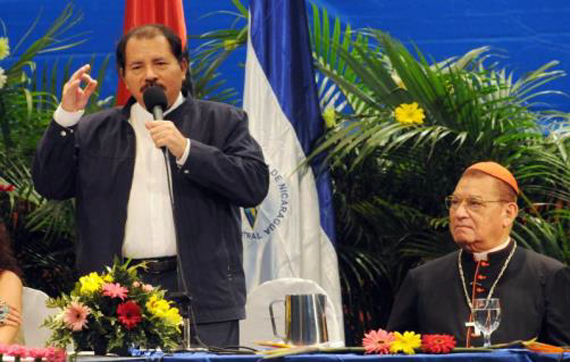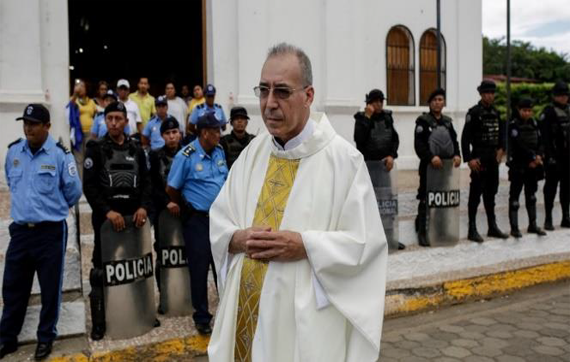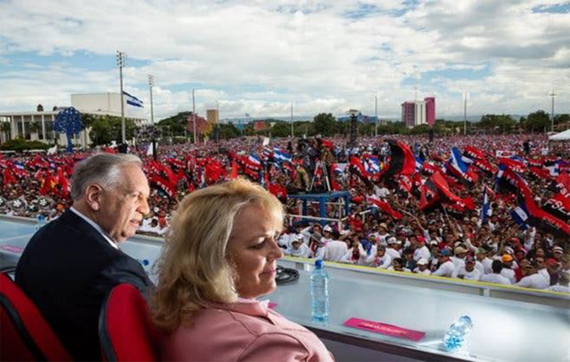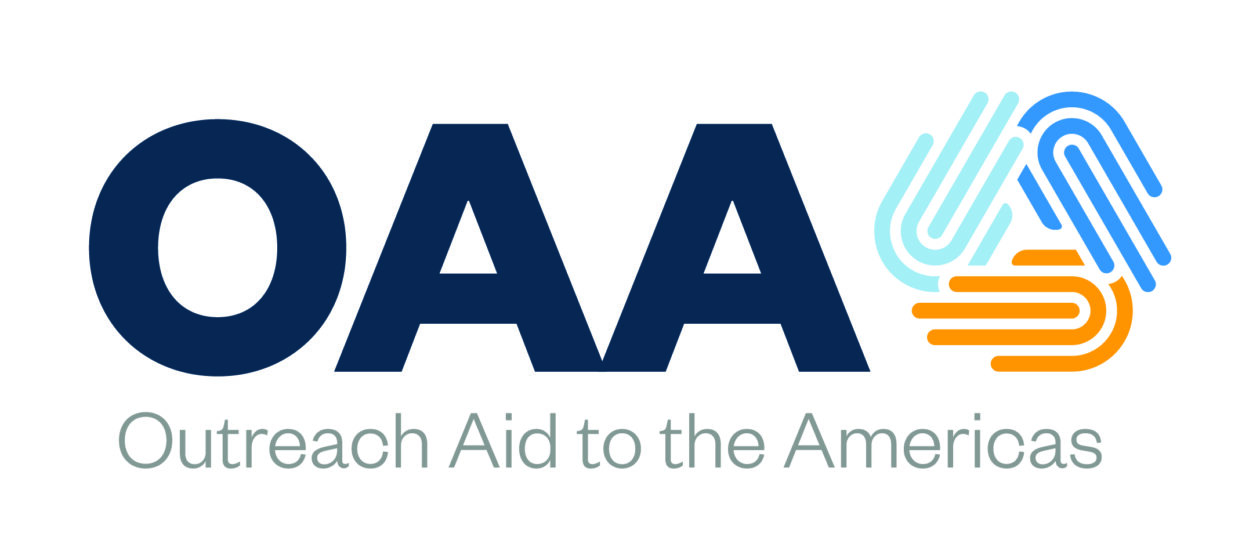Nicaragua’s Evolving Religious Freedom Crisis
Nicaragua’s status as a country where religious freedom is respected has been put at risk by President Daniel Ortega and his FSLN political party. The government’s harsh treatment of members of the faith community has increasingly deviated from international standards for freedom of religion. The international development community should consider assistance programs that educate Nicaraguan faith leaders on basic human rights, unify the faith community towards shared objectives, strengthen the role of faith organizations as essential civil society members, and support advocacy initiatives that promote religious freedom as an essential human right.

President Daniel Ortega strategically embraced Catholicism in 2006 through his relationship with Bishop (later Cardinal) Obando y Bravo (Miguel Alvarez, AFP, Getty Images).
A Historically Diverse and Amicable Religious Landscape
Nicaragua is the second poorest country in the Western Hemisphere and has suffered periods of extreme political unrest and conflict. The country, however, is characterized by a diverse religious landscape that arguably has tempered instability by promoting values of tolerance, peace and reconciliation among its overwhelmingly faithful majority. In the last census, in 2005, Catholics made up 59 percent of the country’s population while 22 percent were evangelical Protestants. An M&R Consultants survey in 2017 found that Catholics had declined to 46 percent of the population, Evangelical members had risen to 33 percent, 14 percent were faithful though non-affiliated, and under 4 percent were Jehovah’s Witnesses, Mormons, Moravian Lutherans, Jews, Muslims, and nonbelievers. Some observers believe that today active Catholic and Protestant church populations are about equal in size. A 1995 study found that there were important political and class distinctions between Catholics and Evangelical groups, with Evangelical churches making greater inroads among poorer,
particularly rural, Nicaraguans historically opposed to the 1979 Sandinista takeover.
Nicaragua’s constitution guarantees freedom of religion, and the government was generally considered to have respected religious freedom through 2010, near the end of Daniel Ortega’s second term as President1. The U.S Department of State’s International Religious Freedom (IRF) report from 2005, for example, commended the Government of Nicaragua (GON) whose “policy continued to contribute to the generally free practice of religion,” and praised “the generally amicable relationship among religions in society that contributed to religious freedom.” In 2010, the IRF report noted the general well-being of religion in Nicaragua.
The Special Relationship with the Catholic Church
Although the State Department concluded, year after year, that there was a healthy separation of church and state in Nicaragua, in fact a self-serving alliance between Nicaragua’s ruling family and the Catholic Church pre-dated the Sandinista takeover in 1979. The Somoza family had allowed some new Catholic missions and
1 Ortega, and his wife Rosario Murillo, were elected as President and Vice-President, respectively, in November 2017. This is Ortega’s fourth term and new presidential elections are scheduled for November 2021. To stay in
power, Ortega has manipulated the Supreme Court into overriding constitutional term limits, systematically suppressed his opposition, controlled the electoral process, and utilized electoral fraud.
education institutions to operate in Nicaragua with the tacit understanding that Catholic leaders avoid politics (e.g., not criticize the ruling family). A new constitution in 1950 staked out the freedom of religious choice, however, it protected broad Catholic interests as the overwhelmingly prominent faith. An appreciative Vatican had no issue with the Somoza leadership, as the church systematically pursued policies of stability in Latin America including through support for some authoritarian leaders, including military-aligned dictatorships. But some Catholic priests in Nicaragua, concerned with issues of inequality and human rights abuses under Anastasio Somoza, deviated from church policy and supported the peasant revolt. Following the 1979 Sandinista takeover, some more radical priests openly participated in the revolutionary government, including as cabinet ministers, despite Vatican pressure to avoid politics. Some priests later became disillusioned and parted ways with Ortega, who they saw as increasingly authoritarian.
Ortega, educated in Catholic schools, was a self-professed Leninist and among many Sandinista atheists. Atheism, though, never found traction as an FSLN policy given the full involvement of many Christians in the revolutionary movement. The party’s official policy in 1969 guaranteed “the freedom to profess any religion” and support for the work of priests and other religious figures2. In 2006, just prior to his successful presidential campaign for a second term, Ortega publicly – and strategically – embraced Catholicism and accepted spiritual mentorship from Bishop (later Cardinal) Obando y Bravo. Following his election, Ortega obtained National Assembly approval for a strict anti-abortion law, thus cementing his relationship with the Catholic leader. Shortly thereafter, Ortega and Murillo were married in a Catholic ceremony officiated by Obando, and they and
their family members were sometimes seen at Catholic mass.
2011-2017: Setbacks in Religious Freedom
In the years that followed, the line between church and state became increasingly blurred3. In the 2011 presidential campaign, the FSLN connected faith with its revolutionary platform, adopting the slogan “Christianity, Socialism, Solidarity,” and using Christian symbols in its propaganda and later in public works. In 2013, the GON introduced obligatory Christian values education in the school curriculum. For the first time, however, religious groups began to report GON harassment for their opposition to official policies. In 2014, a new family law entrusted community Family Committees to promote Christian values and began exerting control over Catholic religious festivities. Religious groups reported the government selectively withheld benefits and delayed customs clearance for imported church goods. In 2015, the harassment of some churches continued, and some GON officials were quoted as making anti-Muslim statements. In 2016, the GON imposed new entry requirements on religious travelers (i.e. missionaries), citing concerns about criminal activities including narcotrafficking. Over the 2016-17 period, official retaliation continued against religious groups and other civil society organizations perceived to oppose the government.
2018: The Faith Community Comes Under Full Attack
The State Department’s 2018 IRF report documents the rapid decline in government respect for religious freedom following a series of destabilizing events. As the year began, the GON continued to officially promote Christianity and use Christian symbols in FSLN propaganda and public works, school curriculum and political speeches. It also continued to impede the visits of individuals coming for religious purposes, and
2 Kreider, Aaron. Liberation Theologies. campusactivism.org, March 1997.
3 State Department information in this paper is sourced from IRF reports for the corresponding years cited.
to block the registration of some religious groups and the import of their goods.

Father Edwin Roman, of Masaya, was one of several Catholic priests targeted by GON and pro-Sandinista groups (Alfred Zuniga, AP photo).
Prior to 2018, the State Department caveated such reports on declining religious freedom standards in Nicaragua by saying that “there were no societal actions” affecting religious freedom. That changed when social security austerity measures in April ignited widescale public demonstrations that were met with harsh repression by police and loyalist FSLN and paramilitary groups. Over the weeks that followed, hundreds of Nicaraguans who opposed Ortega, including many students, were killed, imprisoned or went missing. The National Assembly, controlled by Ortega’s Sandinista Party, passed repressive anti-terrorism measures to outlaw demonstrations and the public use of patriotic symbols such as the flag and its colors. Nicaragua’s economy collapsed as investors retreated and 65,000 Nicaraguans fled the country. Although some prisoners were released in 2019, about 150 remain incarcerated and are considered political prisoners. There was U.S., regional and global condemnation of Ortega’s human rights abuses, and broad sentiment in Nicaragua that he and his wife must step down, or failing that, that new elections be held. After a short period of dialogue mediated by mostly Catholic leaders, Ortega resisted those calls and consolidated control through party loyalists, including the leadership of the police and the military.
equally guilty of human rights abuses. Leaders like Managua Auxiliary Bishop Baez and Cardinal Brenes took on prominent leadership roles. Baez, however, was called to Rome by the Vatican when he received death threats. Many priests, who sheltered individuals in their churches, remain under attack by paramilitaries. There was solidarity on the part of some Protestant pastors, but the principal supporters to those opposed to the government were Catholic leaders.
Civil Society in Retreat, Faith Leaders Step Forward
Ortega, who in the past used soft repression to control civil society, clamped down. He cancelled the registration of several prominent CSOs, detaining their leaders and confiscated their assets. Many had been USAID and other donor civil society grant recipients: Nicaraguan Center for Human Rights (Centro Nicaragüense de Derechos Humanos – CENIDH), Center for Health Information and Advisory Services (Centro de Información y Servicios de Asesoría en Salud – CISAS), The Center for Communication Research (Centro de Investigación de la Comunicación- Cinco), Let’s Do Democracy (Hagamos Democracia), Las Segovias Leadership Institute, The Institute for Development and Democracy (Instituto para la Desarrollo y la Democracia -IPADE), the environmentalist Fundación del Río and The Institute of Strategic and Public Policy (Instituto de Estudios Estratégicos y Politicos Públicas – IPADE).
Over the last 20 years, Ortega and allied Sandinistas bought up radio, TV and print outlets. Following the April 2018 revolt, Ortega cracked down on remaining independent outlets, forcing many to close (including Nicaragua’s second largest newspaper, El Nuevo Diario), killed at least one journalist and forced others to flee the country. The government also made It difficult for international NGOs, who often depend on local NGO partner arrangements, to operate. The government also used bureaucratic tactics to impede humanitarian actors. For example, Caritas, the Catholic aid charity, has had its imports of medicine and food blocked.
When authoritarian governments repress civil society organizations, the faith community often becomes the last bastion of citizen defense. As threatened Nicaraguans sought refuge in churches, the Catholic church leadership took on a major role as human rights defenders and negotiators for a peaceful dialogue – something it had been reluctant to do when Somoza was photographed praying with Evangelical church leaders and seem to have eschewed Catholicism for Evangelism.
Public Funding and Property for Favored Churches
Although the newest constitution states that Nicaragua has no official religion, Ortega’s government doled out almost $20 million between 2007 and 2018 to churches, religious foundations and the Catholic university, UNICA4. The motive, at the front end, seems to have been positive, in that the government assisted the Catholic church in maintaining large historical cathedrals and churches that were part of the national heritage when parishioners could not meet those costs (an example is the Cathedral of Leon that received over $1 million during the time period). But it appears to have been driven by Ortega’s political bond with Cardinal Obando y Bravo and his continued alliance with former President of the Supreme Electoral Commission (SEC), Roberto Rivas, who had become Vice Rector of UNICA5. Out of the $20 million, 43.29 percent went to UNICA, or about $600,000 per year.
Ortega’s Shift Towards Evangelicals
The post-April 2018 humanitarian actions of Catholic leaders widened a schism that had been growing between Ortega and the Catholic church. As Catholic leaders sheltered citizens that opposed the government and took on roles that Ortega perceived as supporting his opposition, he responded with police and paramilitary attacks against Catholic leaders and church facilities. The Ortega-Murillo family tactically turned their backs on the Catholic church and expanded their ties with Evangelical leaders.
Although some Protestant leaders spoke out against government-sponsored repression, Ortega and Murillo apparently felt that the Evangelicals were logical allies. The fact that Evangelical churches are Nicaragua’s fastest growing denominations was clearly a motive. In early 2019, Ortega’s son, Laureano Ortega – thought to be a political heir apparent – and his wife were photographed in staged participation at an Evangelical church service in Managua and were quoted as saying they were active Evangelicals. Ortega and Murillo have also been
But by 2018, increasing grants were going to numerous evangelical Protestant groups, totaling 12.5 percent of the multi-year budget. The Protestant funding was directed to 888 associations, one federation and 143 foundations, all of whom are identified as Evangelical. Funds also went to 23 associations and two foundations that are described as Baptist, and five associations that are identified as Adventist. Together these make up 1062 of the 1100 religious entities that received funding
Department of State accused him of “significant corruption” and electoral fraud and he was hit with U.S. sanctions. Rivas became Vice Rector of UNICA, where his sister serves as Rector. Rivas’ mother was Obando’s personal assistant and it is rumored that Obando fathered Rivas. UNICA had also benefited from public funding during the corrupt administration of Arnoldo Aleman who formed a working alliance with Obando.
4 Guevara, Maryorit. Los Millones de La Fe en Nicaragua, and Los Discipulos de Ortega. La Lupa, October 2019.
5 As SEC President, Rivas ensured Ortega’s electoral success by manipulating electoral rules, voter access and vote counts. Rivas acquired luxurious homes, planes, a yacht and vehicles on his salary of $60,000 per year. He was considered as “above the law,” though forced to step down in 2017 after the
between 2007-18. Some of the funds went directly to religious leaders, and accountability of the funding is not clear.
provides spiritual support to members of Donald Trump’s cabinet and White House officials8. He was in Nicaragua to promote the creation of a branch of his high-level Bible study group. But Drollinger walked out of an event celebrating the 40th anniversary of the Sandinista revolution when a speaker, the Vice-President of Venezuela, condemned U.S. actions in the region. Drollinger’s visit raised eyebrows but did little to mend bilateral ties or reduce pressure that the USG is applying to the Ortega-Murillo regime.

The Sandinista government has delivered more than 800 property titles to Evangelical churches (19Digital, March 2018).
On October 29, 2019, property titles were delivered to 67 pastors of Evangelical churches aligned with the government6. This action built on previous government efforts that resulted in the legalization of 853 properties belonging to Evangelical churches of a reported 2000 requests that were pending. Evangelical churches are also benefiting directly from funding assigned to National Assembly legislators who are distributing their quotas of discretional social funding to those churches. Ortega and Murillo have assigned funds to several biblical inspired works in Managua and other cities. As sociologist Maria Teresa Blandon commented, “there are many, many government officials who are acting like they were Evangelical pastors7.”
The post-April 2018 GON human rights abuses have brought significant U.S. Government criticism. Vice President Pence criticized the Ortega government’s treatment of Catholic leaders and those who stand in opposition to the government. Ortega has tried to use his new Evangelical relationships to diffuse the bilateral threat. In July 2019, he and Murillo met with Ralph Drollinger, an American evangelist who
6 67 Evangelical Churches Allied with Ortega Receive Property Titles. Nicaragua Investigates. October 2019.

Ralph Drollinger and his wife, Danielle, before he spoke in Managua, Nicaragua. New York Times, October 29, 2019
GON Abuses of Religious Freedom
Although the U.S. Department of State has focused some attention on the deterioration in religious freedom in Nicaragua, the situation is clouded by certain factors. Foremost, Nicaragua remains a country made up of an overwhelming majority of faithful citizens who do have relative freedom to choose their religion. As well, the GON has allowed diverse faith groups to be registered and operate in the country. And Ortega has provided public funding to Catholic, Protestant and small denominations. On the surface, this makes it appear that the government wants supports the faith community, their social service outreach and their upkeep of important heritage sites (in the case of the Catholic church). These are factors
7 Guevara, ibid.
8 Schwartz, Mattathias. How the Trump Cabinet’s Bible Teacher Became a Shadow Diplomat. New York Times, October 2019.
– right to use of religious symbols: the Sandinistas have utilized Christian symbols even though the constitution does not recognize a state religion. GON-affiliated groups vandalized religious places and artifacts. They have made copies of patron saints and used religious language, beliefs and traditions for political purposes. They have politicized religious festivities and required government workers and students to participate in government prioritized religious events.
that, to this point, may have served to fend off deeper criticism from religious freedom watch dogs, including the U.S. Commission on International Religious Freedom and the UN Special Rapporteur for Freedom of Religion or Belief.
But the increasing tendency of the government to favor some churches over others at its political convenience, dole out public funding to dampen criticism of its human rights abuses, as well as regulate religion through registration and visa processes, demonstrate that religious freedom is under attack. It is concerning that these actions, that alternately reward and punish certain faiths, have the effect of dividing the faith community when unity among its members is what is most required, including a commitment to call out abuse and advocate for other faiths and faith leaders. Whether this is an unintended consequence, or whether the government is dividing churches by design, needs to be scrutinized by civil society and the international community.
But according to international human rights standards, are there clear and verifiable abuses of religious freedom in Nicaragua? The UN identifies universally held or agreed to rights and freedoms that directly protect religious freedom9. Some of these stand out when viewing the post-April 2018 situation in Nicaragua and issues raised in the 2019 IRF report and other public sources:
– freedom to worship and assemble: the GON and aligned groups have impeded Catholics from worshipping, including by entering churches, by blocking access, and by tactics such as using loudspeakers near churches for music and political speeches. There were also several attacks on Catholic churches. These groups directly intimidated and physically attacked Catholic priests and other faith leaders.
9 UN High Commissioner on Human Rights. International Standards on Freedom of Religion or Belief.
similar to the priority that Sandinista party members have historically received as determined by FSLN-controlled community committees.)
– when the state recognizes an official religion, it shall not impair practice of other religions: while there is now no official religion, Catholicism had that distinction almost 50 years ago when that religion was dominant. Today, when the religious landscape is more diverse, the current government invokes Christianity, and increasingly Evangelism. The Ministry of Education requires Christian principles to be part of its education curriculum. The GON requires government workers and students to participate in Christian festivities. The constitution also entrusts Family Committees to promote Christianity. The GON Human Development policy promotes religious and faith-based festivities. The FSLN includes Christianity in its slogan, and freely uses Christian symbols in its propaganda and in public works.
– right of prisoners to practice their faith: Catholic leaders say they have been impeded from administering to prisoners.
Targets of Opportunity for Advocates of Religious Freedom
Outreach Aid to the Americas, like other advocates for international religious freedom, has learned the importance of a unified faith community when religious freedom is under attack. Cuba, an active model for the Ortega dictatorship, and a country where OAA has worked on democracy, development and faith initiatives for 25 years, is the best regional example of where an authoritarian government purposely undermines unity within the faith community. The Cuban government rewards a few churches by allowing some limited space to operate, tolerates a few others who must practice their faith cautiously, and actively represses other denominations that must worship in the shadows, and whose leaders and members are harassed, denied basic
– right to teach, write or disseminate religious materials: the GON has controlled and some cases denied the access of Catholic and Protestant missionaries (which is an established right) through the visa approval process.
– registration to guarantee exercise of religion: the GON has used registration, including the granting of land titles, to selectively allow or deny religious groups to practice as well as to reward political allies.
– right to establish and maintain appropriate charitable and humanitarian institutions: Caritas and other organizations are being impeded from operating, including by blocking their imported goods and punishment through deregistration. Religious groups say that the fact that their organizations are bureaucratically treated like NGOs makes them more vulnerable to discrimination.
– discrimination on basis of religion: religious leaders accuse the GON of slandering, stigmatizing and urging its followers to retaliate against certain churches and clergy. There has been financial retribution against some churches through removal of tax exemptions, reallocation of government funding, and targeting by the Financial Analysis Unit for money laundering. (It is worth watching to see if certain religious groups get improved access to GON services – like land titling, which has already occurred –
https://www.ohchr.org/EN/Issues/FreedomReligion/Pages/Standards.aspx
employment and education rights, and even imprisoned. The Cuban government regulates faith and utilizes an obscure system of administrative decrees and laws to punish religious leaders and their followers. The result has been disunity within Cuba’s faith community, though recently there have been positive signs that churches are banding together and are willing to take a public stand and to support one another.
Clearly, Nicaragua’s divided faith community needs technical assistance to provide a platform for promoting an open society where the faith community is free of government interference, and where churches can be advocates for civil society and human rights. Unfortunately, as well-equipped as many clergy members are to lead their congregations and to speak out on important political and community issues, these faith leaders can be self-serving and often do not understand the greater good of religious freedom for all members of the faith community. They need to learn from the experience of other countries where a healthy separation of church and state best guarantees this essential human right. As such, faith leader education programs based on international experience and that promote UN and other international standards for freedom of religion and belief is an effective platform for developing a strategy for unifying faith leaders, strengthening faith organizations as viable civil society members, and advocating for religious freedom as an essential human right.
